May 7, 2010
Air Date: May 7, 2010
FULL SHOW
SEGMENTS
Lack of Oversight on Drilling Safety
View the page for this story
The Deepwater Horizons Drilling operation was not required to perform an environmental review, which some critics say should be required. Jeff Ruch of PEER, Public Employees for Environmental Responsibility, tells host Jeff Young that the Minerals Management Service (MMS) routinely passes oil drilling operations without environmental assessment. We also hear from Marc Gaffigan of the Government Accountability Office who says a government report shows that MMS employees lack official guidance for environmental protocol. (06:15)
Spill Threatens Climate Bill
/ Mitra TajView the page for this story
A Senate proposal to cap emissions has been on shaky ground since BP's oilrig exploded in the Gulf of Mexico. Encouraging an expansion of offshore oil drilling was central to securing broad support for the legislation, but now some coastal Senators are vowing to kill the compromise bill. Living on Earth’s Mitra Taj reports on how one of the biggest oil spills in U.S. history could end up derailing legislation to address climate change. (05:45)
Losing the Chance to Find Out
/ Ingrid LobetView the page for this story
Consider the surface area of the grasses and rushes in a giant estuary. That's what lovers of the Louisiana, Mississippi, Florida and Alabama marshes are doing as they contemplate the petroleum product gushing from the former Deepwater Horizon drill rig. Bill Finch, Alabama conservation director for The Nature Conservancy, takes us along on what he hopes won't be his last walk through the unspoiled Grand Bay marsh. Living on Earth’s Ingrid Lobet reports. (06:30)
Reforming Toxic Chemical Regulation
/ Bruce GellermanView the page for this story
There’s growing evidence linking industrial chemicals to chronic diseases and birth defects. Seventy-four billion pounds of chemicals are produced each day in the U.S. yet few of the ingredients have been evaluated for safety. Living on Earth’s Bruce Gellerman reports on attempts to overhaul how the nation regulates industrial chemicals. (09:30)
Marsh Fork Elementary Update
View the page for this story
An elementary school in a small West Virginia community sits precariously close to a coalmine. Host Jeff Young talks with resident Ed Wiley about his successful campaign to raise money to rebuild the school out of harm’s way. (06:10)
From Court House to Home
View the page for this story
In Kansas City, an abandoned historic courthouse is getting a second lease on life. Host Jeff young speaks with Joe Alexander, president of the Alexander Development Company, about the benefits of adaptive re-use. (06:20)
A Repurposed Life
/ Cambrey ThomasView the page for this story
A Detroit movie theatre made from salvaged parts causes Living on Earth and Planet Harmony’s Cambrey Thomas to think about second chances for trash. (03:30)
Show Credits and Funders
Show Transcript
HOST: Jeff Young
GUESTS: Jeff Ruch, Mark Gaffigan, Ed Wiley, Joe Alexander
REPORTERS: Mitra Taj, Ingrid Lobet, Bruce Gellerman, Cambrey Thomas
[THEME]
YOUNG: From Public Radio International - this is Living on Earth.
[THEME]
YOUNG: I’m Jeff Young. Oil hits the Gulf shore, and officials look for answers in the massive BP blowout. Government watchdogs say the federal agency in charge of offshore drilling is part of the problem.
RUCH: With respect to this rig, they found that there was no need to even do an environmental review because the risks of damage from the spill were so minimal.
YOUNG: The government’s Minerals Management Service, under the microscope. Also, how the big spill is changing energy politics. Coastal Democrats push back against the president’s drilling plan.
NELSON: I will make it short and to the point. The president’s proposal for offshore drilling is dead on arrival.
YOUNG: We’ll hear why that could make it harder for Congress to act on climate change. Those stories and more this week on Living on Earth. Stick Around!
ANNOUNCER: Support for Living on Earth comes from the National Science Foundation, and Stonyfield Farm.
Lack of Oversight on Drilling Safety
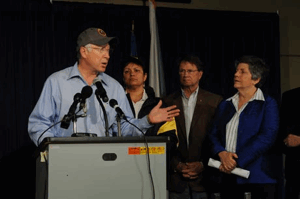
At a press conference in Louisiana, Department of Interior secretary Ken Salazar pledges to review offshore oil drilling safety. (Courtesy of Minerals Management Service)
YOUNG: From the Jennifer and Ted Stanley Studios in Somerville, Massachusetts—this is Living on Earth. I’m Jeff Young. The race is on in the Gulf of Mexico to limit damage from a massive oil gusher.
And the heat is on in Washington where Congress is looking for answers as to what went wrong. We have reports on both; we begin in Washington. Just a month before the BP rig exploded Congress’ own investigative office sounded the alarm about systemic weaknesses in the regulation of offshore drilling.
And federal officials responsible for enforcing the law in public waters exempted the BP rig from a full environmental impact analysis. Jeff Ruch directs the nonprofit watchdog group Public Employees for Environmental Responsibility, or PEER. Ruch says the Department of Interior’s Minerals Management Service, or MMS, gave that BP rig a pass.
RUCH: MMS has taken the posture on this rig and rigs elsewhere offshore that the risk of spill and the consequences of spills are minimal and not to be a matter of concern. With respect to this rig, they found that there was no need to even do an environmental review because the risks of damage from the spill were so minimal.
YOUNG: What do we know about decisions being made on whether or not to drill in other potentially sensitive areas, say, the newly opened lease areas in the waters off Alaska?
RUCH: Well, the Government Accountability Office issued a report last month that took MMS to task for suppressing an array of critical findings on issues like liquid oil spills, acoustical damage to whales.
And they found things like the scientists at MMS are under pressure to turn out reviews that omit important environmental concerns and conditions were so oppressive that in the five years that they looked at, in some years as many as 50 percent of the analysts left the Alaska office.
YOUNG: That GAO report Ruch cites also sheds light on larger problems with how the Minerals Management Service makes offshore drilling decisions. Mark Gaffigan wrote the report. He’s GAO’s Director for Natural Resources and the Environment.
GAFFIGAN: What we found is that there seemed to be a lack of a good policy framework for how they do that analysis. In Department of Interior, for example, calls for a guidebook on how to do these things, and MMS did not have one.
YOUNG: So, in the case of the deepwater horizon drill the officials there decided not to require this environmental review, but what guidance did they have to make that decision?

At a press conference in Louisiana, Department of Interior secretary Ken Salazar pledges to review offshore oil drilling safety. (Courtesy of Minerals Management Service)
GAFFIGAN: Well, we felt without the handbook that they didn’t have good criteria for making that decision. And what they missed out on was a much more detailed environmental impact statement, which would provide a lot more multiple opportunities for public comment and require plans for mitigating the potential impact—looking at the assessment of could this adversely affect fisheries in the Gulf of Mexico and could it affect the general water quality, damage the ecosystem? All those sorts of considerations need to be weighed when considering oil and gas development.
YOUNG: That certainly seems like a big deal now.
GAFFIGAN: It sure does.
YOUNG: So, there’s a lot of focus obviously now on what went wrong in the Gulf, and how to change policy to improve things. What would be your recommendations?
GAFFIGAN: What needs to be recognized is that oil and gas development in the United States has a long history. And we have drilled more wells than any other place in the world. And what’s quickly forgotten is that the U.S. is still the third largest producer of oil in the world behind Russia and Saudi Arabia because we are so well developed and we have explored in a lot of areas, we’re starting reach out to the harder areas.
And the degree of difficulty in producing oil in deep waters increases, and there’s some increased risk. And those considerations need to be carefully looked at when we’re thinking about going further and further out, trying to get this oil that’s difficult to obtain.
GAFFIGAN: That’s Mark Gaffigan of the Government Accountability Office. In a March letter, Minerals Management agreed with many of Gaffigan’s recommendations. But it’s not clear if any changes have been made. Jeff Ruch of the watchdog group PEER says the agency’s entire culture needs to change.
Under the Bush administration, the Interior’s number two official went to prison on corruption charges, and an internal investigation found some minerals management staff doing drugs and sleeping with oil company employees. The Obama administration pledged to end corruption. But Ruch points out that it was on Obama’s watch that BP’s drilling plan got its final approval. Ruch says the agency’s problems are chronic. Even its dual mission is a challenge—it both polices and promotes offshore drilling.
RUCH: Their primary role is to collect the government cut, the royalties, and they’re also supposed to make sure that the operations are done according to law. And the principle laws involve protecting the environment from many effects, principally, oil spills.
YOUNG: Is there a conflict there?
RUCH: There is a conflict, but for almost its entire history it’s always been resolved in favor of promotion. MMS has never been known as an alert cop on the beat.
YOUNG: President Obama’s Interior Secretary, Ken Salazar, when he was selected he told the public and members of Congress that cleaning up Interior, and in specific, this office, Minerals Management Service—this was one of his top priorities.
RUCH: President Obama promised a policy a year ago to protect scientists and government science from political manipulation, those rules were supposed to have been in place in July and they’re unaccounted for; we don’t know where they are. The Interior department itself has no scientific code of conduct. In terms of scientific integrity, protection of whistleblowers, Secretary Salazar’s been completely missing in action.
YOUNG: Jeff Ruch of PEER. The Interior Department did not respond to our requests for comment. The real test of whether the department has made changes may come in Alaska’s waters—a spot where the GAO found many shortcomings. Shell Oil plans exploration drilling there as soon as July 1st.The big spill has also churned up the politics of oil and climate on Capitol Hill, as Living on Earth’s Mitra Taj reports.
Related links:
- Minerals Management Service
- Government Accountability Office
- PEER article on Alaska GAO report
- Click here to hear a longer interview with Jeff Ruch
Spill Threatens Climate Bill

Senator John Kerry (D-Mass) says he's still hopeful a climate bill can pass this year. (Courtesy of Senate Democrats)
YOUNG: The big spill has also churned up the politics of oil and climate on Capitol Hill, as Living on Earth’s Mitra Taj reports.
TAJ: It was a carefully crafted compromise: a Senate proposal capping greenhouse gas emissions to slow global warming. To make it more politically viable—a big concession for the oil industry, as put forth by President Barack Obama last month:
OBAMA: Today we’re announcing the expansion of offshore oil and gas exploration.
TAJ: Just weeks later, BP’s Deepwater Horizon offshore oilrig blew up. And it didn’t take long for some coastal Democratic Senators to ride the oily waves of political opposition heading for their shores:
NELSON: I will make it short and to the point. The president’s proposal for offshore drilling is dead on arrival.
TAJ: Florida Senator Bill Nelson and New Jersey Senators Bob Menendez and Frank Lautenberg gathered on the lawn in front of the Capitol building to demand a renewal of the moratorium on offshore drilling that expired in 2008. They’re also channeling their outrage into a new bill that could hold oil companies liable for damages of up to 10 billion dollars. Senator Menendez:
MENENDEZ: People ask us, well isn’t that an extreme amount? Well BP made five point six billion dollars in profits in the last quarter alone, I think they can be responsible for their actions.
TAJ: But the spill spells trouble for what many saw as the Senate’s best shot at tackling climate change. A bipartisan proposal aimed to break the country’s foreign oil addiction, back up the president’s international pledge to limit emissions, support the coal industry through a greener economy—it had something in it for almost everyone—and expansion of offshore oil and gas exploration was key. Now the three Democratic Senators who were likely “yes” votes have joined those who have vowed to kill the climate change bill. Senator Nelson of Florida:
NELSON: If offshore drilling off of the coast of continental United States is part of it, this legislation is not going anywhere. And if I have to do a filibuster, I will do so again. And fortunately I think we’re going to have a lot of help now.
TAJ: The climate change bill was already a huge task for this divided Senate. Even before the gushing started in the Gulf, the proposal was thrown off course when its Republican co-sponsor, Lindsey Graham, abandoned the effort. Now its remaining sponsors, Senators John Kerry and Joe Lieberman are looking left and right to rebuild support.
[SOUNDS OF TALKING, ECHOED INDOORS]
TAJ: In the halls of Congress after the press conference, the Senators walked fast.
KERRY: I haven’t even talked to Lindsey. [TO REPORTERS] When the moment is appropriate I will give you a sense of where we are heading.
TAJ: Are you still optimistic?
KERRY: Yes, I remain very optimistic.
TAJ: Why?
KERRY: Because we’re going to pass a bill.
TAJ: With who’s support?
KERRY: With 60 senators.
[SOUNDS OF ECHOED HALL]
TAJ: Kerry’s been struggling to find the political equation that will deliver the 60 votes needed to overcome a filibuster. And since the Gulf disaster, the math has become more complex. Key now is what—if anything—should be written about offshore drilling. Lieberman says he won’t drop support of offshore drilling from the proposal.
LIEBERMAN: Uh because there were good reasons for us to put in offshore drilling and this terrible accident is very rare in drilling. You know, I mean, accidents happen.
TAJ: He says the bill could keep them from happening:
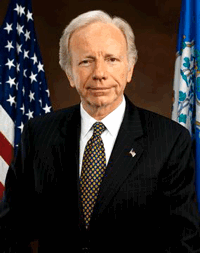
Senator Joe Lieberman (I-Conn) says he wants to keep support for offshore drilling in the legislation. (Courtesy of Senate Democrats)
LIEBERMAN: The proposal we’re making, and I may be announcing this, it’s no big deal but is that you can’t drill within shorter than 75 miles from the coast, and we’re giving adjacent—we’re giving states the veto—I got to run!
TAJ: But seventy-five miles from the shore isn’t far enough for Senator Lautenberg of New Jersey.
LAUTENBERG: No, because my gosh, if we don’t see that oil no matter what speed it travels at can go a hell of a lot further than 75 miles then we’ve got our heads in the sand, we’ve got a different kind of problem.
[FADE AMBIENCE]
TAJ: The oil industry has been keeping careful watch of political changes afoot on Capitol Hill. Sarah Banaszak is a senior economist for the industry’s chief lobbying group, the American Petroleum Institute:
BANASZAK: There’s no indication that the industry can’t work effectively under regulations put forth by the government, work with the government to design the right regulations. I believe that that process still works effectively.
TAJ: Environmental groups are split, some calling for a permanent ban on offshore drilling, and others willing to keep it on board if it means passing a climate bill.
Steve Cochran is the national climate change director for Environmental Defense Fund, an organization that’s been working closely with the sponsors of the climate proposal. He says if the legislation puts in strong regulations for existing offshore drilling, while being neutral about new offshore drilling, it might find safe ground.
COCHRAN: We need to have protections in place today—then we can have a conversation about additional drilling. Tempers are pretty high right now; this is a bad thing going on in the Gulf. I would be very surprised to see a bill go forward that had incentives for drilling at this stage in the process.
TAJ: A native of Louisiana, Cochran says he hasn’t lost hope yet.
COCHRAN: These things get negotiated. That’s the nature of the Senate, it’s a deliberative body, sometimes it’s not very pretty in the process, but I believe based on conversations with staff, and listening to people that there are paths forward. I mean the irony of ironies would be that if the reason that a bill, which is fundamentally designed to remove our dependence on oil, was killed because of an oil spill—we have to be better than that.
TAJ: Senators Kerry and Lieberman say they’ll launch their climate bill in coming days, but there aren’t that many days left before Congress gets distracted by the election season. For Living on Earth, I’m Mitra Taj in Washington.
[MUSIC: Trombone Shorty “Right To Complain” from Backatown (Verve Records 2010)]
Related links:
- Click here to read Senator Nelson's letter to the president.
- Read Senator Kerry's recent speech about why climate change legislation is important.
- Learn why many environmental organizations want to stop expansion of offshore drilling.
- Read President Obama's speech last month on expansion of offshore oil and gas exploration.
- Coastal Democrats Push Back Against Drilling
YOUNG: Just ahead—what’s at stake in the Gulf—keeping watch from the pristine marshes of Grand Bay. Keep listening to Living on Earth!
Losing the Chance to Find Out
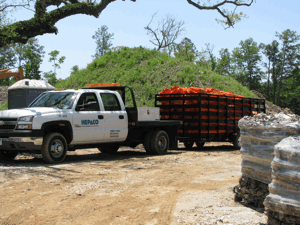
A yard used for an oyster restoration project becomes a staging ground for oil booms in Bayou La Batre, Alabama. (Photo: Ingrid Lobet)
YOUNG: It’s Living on Earth, I’m Jeff Young. Protecting the environment is vital to the people of the Gulf Coast – to the fishermen, to the hotel and business owners, to environmentalists, and perhaps to no one more than Bill Finch.
He’s Conservation director for the Alabama Nature Conservancy, and he took Living on Earth’s Ingrid Lobet to one of his favorite places. It’s neither land – nor water -– the pristine Grand Bay marsh.
[SOUNDS OF WALKING]
FINCH: The first thing you notice is the fact that you just see forever, not just out to ocean, but all around this fringe of marsh, all across Grand Bay. The quietness of the marsh, just the absolute lack [sigh] of any appearance of human disturbance for as far as you can see.
[SOUNDS OF WALKING]

Just on the dryer margin of the Grand Bay marsh in Alabama, there's a bog of carniverous pitcher plants. (Photo: Ingrid Lobet)
FINCH: We’re in the middle of the open marsh and with black needle rush, and you know why it's called black needle rush you can see because when you put your arms down, it will impale your arms.
But then right where we're standing in this river of green that is only about ankle high, this is the salt pan, a salt flat, a special feature of a marsh where salt gets deposited and creates a special community and very diverse. And the great thing about this time of year is that the salt pans that are usually very dry and crusty with salt, they sort of bloom and grow this time of year and they get flooded.
[SOUNDS OF MARSH HEN]
FINCH: And right on the edge of this salt flat, it dips down into the Gulf of Mexico. This whole ecosystem is really about absorbing the Gulf of Mexico this time of year, sucking it up, drawing it in. That contact with the deep ocean this time of year really regenerates this habitat. It's this time of connectivity to the Gulf when it is at its peak. But it’s the very worst time for an oil spill to be coming in because the marsh is so accepting of everything the Gulf throws it.
[SOUNDS OF MOVEMENT OF CLOTHES]
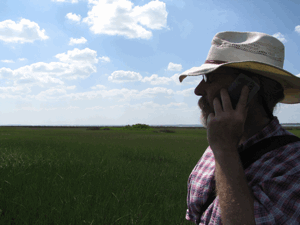
Local conservation legend Bill Finch in the Grand Bay marsh south of Mobile, Alabama. (Photo: Ingrid Lobet)
FINCH: Look at the crabs. Hundreds of crabs. Thousands of crabs. All through this marsh just look at all of them! It's incredibly productive—shrimp, fish of all types—this is a real important nursery area for all types of fish—redfish, which are a real popular sports fish here, speckled trout, shrimp, crabs, virtually everything we eat out of the Gulf.
[SOUNDS OF WALKING THROUGH WATER]
FINCH: Periwinkles everywhere, this is, I don't know which species of marsh periwinkle this is—it’s a snail.
LOBET: It’s climbing up these salt grasses.
FINCH: Up the saw grasses. But it is a periwinkle, a marsh periwinkle, and they are just really abundant. They are the primary grazers of this marsh. When things get disturbed, there is a real concern that marsh periwinkles—the snails—may overgraze a marsh and kill it. What are those disturbances?
The marsh gets stressed by too much oil; maybe the oil kills the chief predators of these periwinkles, which would be crabs. And so you don't have as many crabs and so the periwinkles just go wild and people might say, 'Oh, well it was the periwinkle that killed the marsh'. Well no, they didn't, they have been here for tens of thousands of years. So we may see the loss of this marsh as occurring not just because the oil is toxic, but because it tips the balance to one species or another that gets an unfair advantage because of the oil.
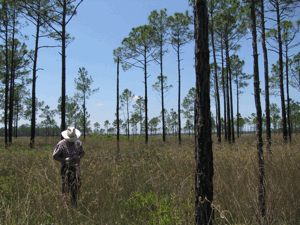
Bill Finch, Conservation Director for the Alabama Nature Conservancy in the slash pine savannah bordering Alabama's Grand Bay marsh. (Photo: Ingrid Lobet)
FINCH: You know the real trouble we have is we don't really know a whole lot about the relationship of crabs to periwinkles, or periwinkles to grass or anything else. And so when the system gets knocked back and we say, ‘Oh we're going to restore this.’ Well we don't know what it was like!
[SOUNDS OF WALKING IN WATER]
FINCH: Look at them, look at them, there they are! See the turquoise on their backs? See that little turquoise streak on the backs of some of those fish? This is that time they are getting ready to spawn. Those are not sailfins. I don't know him.
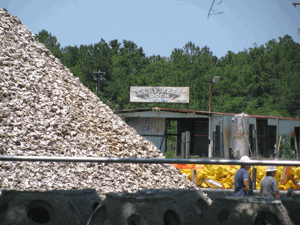
South Alabama residents work to protect their coastline. A mountain of spent oyster shells that was part of an oyster reef restoration project is alongside. (Photo: Ingrid Lobet)
Ah…We need a time to go through and just figure out what's in here! What all is using these saltpans! Look at this male there!! Look at him! Staking his territory out, see him over here? Fluttering around, beating up on the other males, running into them, showing off his tail, showing off his fins—this is that time.
[SOUNDS OF MARSH]
LOBET: You were so busy yesterday and I know that you are so busy today with your phone going off, and yet you’re spending a fair amount of time out here. I'm wondering maybe this is the place you feel that you should be, today.

A yard used for an oyster restoration project becomes a staging ground for oil booms in Bayou La Batre, Alabama. (Photo: Ingrid Lobet)
FINCH: [long pause] These places are largely ignored. We do very little to protect them under the best of situations. But it is important that people know what it is like when it is healthy and how vibrant it is, and how important it is to the entire Gulf of Mexico.
So yeah it is important that I be here. You almost feel torn enjoying such a beautiful place, such a beautiful day, when you fear what’s so imminent. And I want to see it one last time. If this is the last time I want to remember everything that was here. I hope it does break my heart. I don't want my heart to be broken, but I'll leave it out there for that to happen because it is important that we see this. I don't want to forget about it.

Rare intact slash pine forest reaches down to the Gulf Coast marsh grasses in Alabama. (Photo: Ingrid Lobet)
[SOUNDS OF MARSH HEN]
YOUNG: Bill Finch, Conservation director for the Alabama Nature Conservancy, with Living on Earth’s Ingrid Lobet at Grand Bay Marsh. There are photos—and much more about the situation on the Gulf Coast at our website, l-o-e dot org.
[MARSH SOUNDS FADE]
YOUNG: Oil spills also leave their mark on our nation’s energy policies. In fact, the modern history of environmental and energy laws is largely the history of spills. In 1969 a drilling rig’s pipe blew out off the coast of Santa Barbara, California, gushing three million gallons of oil into the Pacific. Reporter Bob Sollen of the Santa Barbara News Press remembers an anonymous phone call.
SOLLEN: It was a male voice. It said, “the Ocean is boiling around platform A” and I don’t know to this day who that person was.
YOUNG: For weeks, images of dead marine life and blackened beaches focused attention on the offshore drilling industry. That helped launch the modern environmental movement, and spurred the creation of the National Environmental Policy Act and the EPA. Twenty years later, in 1989—Captain Joseph Hazlewood radioed the coast guard from his ship in Alaska’s Prince William Sound. A ship called the Exxon Valdez.
[MEN SPEAKING OVER RADIO “Valdes traffic, Exxon Valdez, over.”]
[HAZLEWOOD ON RADIO: “Evidently, we’re leaking some oil, and we’re going to be here for a while.”]
YOUNG: At least 11 million gallons of crude dumped into the arctic sea. Congress responded with the Oil Pollution Act—banning many oil tankers from operating in the Arctic Sound and requiring ships to have spill-resistant double hulls.
It’s too early to tell just how much oil will eventually pour into the Gulf of Mexico or just how political leaders will respond. But if the past is any indication, this disaster could very well decide the Obama Administration’s environmental legacy.
[MUSIC: Rachel Z “Carey” from Moon At The Window (Tone Center Records 2002)]
Reforming Toxic Chemical Regulation
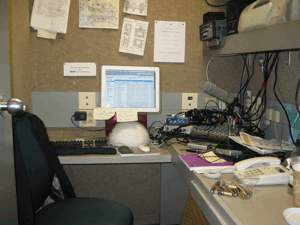
Living on Earth's Washington studio on Capitol Hill. (Photo: Bruce Gellerman)
YOUNG: According to the Environmental Protection Agency, 74 billion pounds of chemicals are produced or imported into the United States each day. That's more than 240 pounds of chemicals—day in and day out—for every man, woman and child in the country. And that doesn't even include chemicals used in drugs, foods, fuels or pesticides.
The federal law that’s supposed to protect people and the environment from industrial chemicals is more than three decades old. And consumer and environmental groups, the EPA, even manufacturers agree—the current regulations governing industrial chemicals are long over due for reform. Living on Earth's senior correspondent Bruce Gellerman reports from Washington.
GELLERMAN: In the Living on Earth broadcast studio on Capitol Hill I'm surrounded by things made from chemicals. The walls and floor are carpeted, the ceiling is insulated tile, my desk is painted, I've got a plastic bottle, my pens and printer are filled with ink, there’s a pile of alkaline batteries. And just look around. Chances are you too are also surround by products made with industrial chemicals.

LOE's Washington Studio on Capitol Hill (Photo: Bruce Gellerman)
WALLS: Our products, our industry’s products touch 96 percent of all manufactured goods.
GELLERMAN: That's Michael Walls—Vice President of Technology and Regulatory Affairs with the American Chemistry Council. It’s a trade group representing the nation’s largest chemical manufacturers.
WALLS: You're talking about an industry that's vital for the national defense. It's vital to the health and safety of all Americans. You're talking about the solutions to some of our global problems like climate change, reducing CO2 emissions is fundamentally a chemistry problem.
GELLERMAN: There are over 82 thousand industrial chemicals registered for use in the United States and that number is increasing by about 700 new chemicals a year—that concerns health advocate Andy Ingrejas:
INGREJAS: It’s true that chemicals are used in almost everything. There’s lots of benefits from chemicals. But I think for most people that’s all the more reason why we should know what’s going on with them.
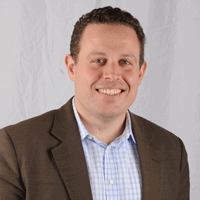
Andy Ingrejas is Campaign Director of Safer Chemicals Healthy Families (Photo: Safer Chemicals Healthy Families)
GELLERMAN: Ingrejas is campaign director of Safer Chemicals, Healthy Families. It’s a coalition of 200 organizations campaigning for changes in the federal law regulating industrial chemicals.
INGREJAS: Chemicals on the market right now are effectively unregulated. The federal government has not reviewed their safety and said this is okay, to be used in all these ways. They have not done that. It’s nothing like we do for drugs.
GELLERMAN: For drugs, manufacturers must prove to the Food and Drug Administration that their chemical compounds are safe.
But under the federal law known as TSCA—the Toxic Substances Control Act—industrial chemicals are automatically considered safe. It’s up to the government to prove they’re not. Senate Democrat Frank Lautenberg of New Jersey has proposed a bill that would radically overhaul TSCA. California Democrat Henry Waxman is leading the effort in the House.
WAXMAN: The Toxic Substances Control Act was adopted in 1976 and it has never been revised, but no one thinks it’s working, even the industry realizes the law needs to be revised.
DOOLEY: Clearly we’re committed to the safe use of our products.
GELLERMAN: Former Congressman Calvin Dooley is head of the American Chemistry Council.
DOOLEY: We think TSCA has been working very well, but we also recognize that after 30 years that there’s opportunities to even enhance it’s effectiveness and utilizing some of the new science and technology to even do a more accurate assessment and comprehensive assessment of the safety of chemicals.
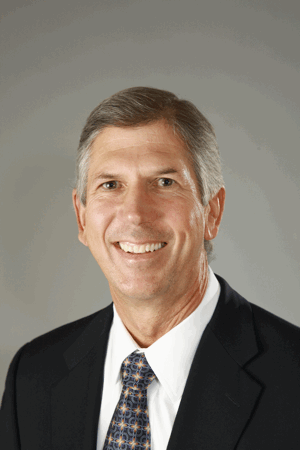
Calvin Dooley is President and CEO of The ACC. (Photo: Calvin Dooley)
GELLERMAN: This represents a major shift in the Chemistry Council’s position—a reaction to growing public concern over environmental toxins. Previously, the Council advocated voluntary measures, but in recent months, congressional and EPA staffers, advocacy groups and industry representatives have been meeting to work out the many technical details for overhauling TSCA. Michael Walls of the Chemistry Council has participated in those sessions.
WALLS: I think that’s what’s remarkable about this issue is that at this stage in the discussion there is a consensus that maybe we can do something. But it’s in the details where the hard work still needs to be done.
GELLERMAN: The devil is in the definitions. Right now, in order for the government to regulate a chemical the EPA has to prove it poses—quote—“an ‘unnecessary risk’ to people or the environment.” Jane Houlihan, vice president for Research at the Environmental Working Group says that’s the first thing that needs to be changed.

Michael Walls is Vice President of The American Chemistry Council (Photo: American Chemistry Council)
HOULIHAN: Under the current system chemicals are innocent until proven guilty and the new proposals would flip that, there would be a burden of proof. Industry would need to provide proof to EPA that the chemicals are safe enough to use.
GELLERMAN: The new standard would require companies to demonstrate—quote—“a reasonable certainty of no harm.” That’s the same standard the federal government now uses to regulate pesticides. The American Chemistry Council agrees the burden of proof should be on manufactures, but president Cal Dooley cautions that adopting the “no harm” standard could hamper innovation.
DOOLEY: I think the question’s now is really in terms of, how do you define that standard? And I think that’s the public policy challenge that we face. What is that risk standard that we’re willing to accept?
GELLERMAN: And how is that standard set and met? Today, the United States is the only developed country in the world that does not require a chemical maker to submit safety data before production. But without the data, how can the EPA determine risk or harm? Again Jane Houlihan of The Environmental Working Group:
HOULIHAN: One thing we have in federal law now is a requirement for companies to submit studies—that they happen to do—there is no requirement to submit studies. If the company determines that that study indicates a significant risk to human health or the environment. Now that’s the company’s interpretation of whether that is a significant risk. If they say, “yeah we think it’s a significant risk” then they submit that study to the EPA. But it’s their discretion.
GELLERMAN: Right now, the EPA has just 90 days to review a new chemical before a company can start selling it. And in only 15 percent of those products does the manufacturer provide the agency with any health and safety studies.
HOULIHAN: It’s such a weak law that EPA has used it to get off the market or set restrictions for only five chemicals or chemical families in the history of the law. They’ve only required testing for about 200 chemicals or chemical mixtures. Now compare that to the 82 thousand chemicals that are registered for use in the U.S. and you see they can only tackle a tiny fraction of what’s on the market.
GELLERMAN: The last time the EPA tried to ban a chemical under TSCA was 1991. That was asbestos, a known carcinogen, responsible for nearly ten thousand deaths a year in the United States. Asbestos is still used in consumer products. That’s because according to federal law the EPA must use the least burdensome option, of all other possible actions, to reduce risk, so banning asbestos is simply not an option.
The proposed Safe Chemicals Act would require companies to provide basic health and safety data for each chemical they produce. It would also create a list of the most dangerous products on the market and give the EPA expanded powers to regulate them. Congressman Henry Waxman wants to go even further. He says manufacturers should have to show how exposure to chemicals affect people in real life.

Congressman Henry Waxman (Photo: Bruce Gellerman)
WAXMAN: I think the approach that we often take that we’re going to look at chemical-by-chemical leads us nowhere. We need to get it on a much faster time frame and look at not just one chemical but the impact of a number of different chemicals in combination.
GELLERMAN: Researchers say environmental exposure to chemicals may be responsible for up to 35 percent of asthma cases, ten percent of cancers, and 20 percent of neurological disorders. But which chemicals? What products? Under current law manufacturers can claim confidentiality; they can keep their ingredients secret. Congressman Henry Waxman:
WAXMAN: People who buy curtains or other products that have chemicals in them have no idea that they may be exposing themselves and their loved ones to something that could cause cancer or other disease. So there is no rationality to the regulation at the federal level to protect the public, to make sure that industry has the rules under which they must operate and to make particularly clear that we want to watch out for the interests of our children who are even more susceptible to toxic chemicals.
GELLERMAN: Proposed updates to the Toxic Substances Control Act would do just that. In the future chemical companies would have to consider the effects their products have on especially vulnerable populations including women, children, people of color and those living near chemical factories. After decades of failed attempts, Congress is now putting the overhaul of TSCA on the fast track. Congressman Waxman hopes the house will vote on it before Memorial Day, and Cal Dooley, the head of the American Chemistry Council is cautiously optimistic.
DOOLEY: You know when you look at the political environment today, you look at the complexity of this issue is that the stars would have to align to see action I think this year.
GELLERMAN: But many states and cities are not waiting for the stars to align. In the absence of federal action a growing number of local governments are moving to restrict. and in some cases ban chemicals the EPA now lacks the ability to effectively regulate. For Living on Earth. I’m Bruce Gellerman.
[MUSIC: John Ellis “Three Legged Tango In Jackson Square” from Dance Like There’s No Tomorrow (Hyena Records 2008)]
YOUNG: Coming up: the man who collected pennies to rebuild a school—that’s just ahead on Living on Earth.
ANNOUNCER: Support for the environmental health desk at Living on Earth comes from The Cedar Tree Foundation. Support also comes from the Richard and Rhoda Goldman Fund for coverage of population and the environment. And from Gilman Ordway for coverage of conservation and environmental change. This is Living on Earth on PRI – Public Radio International.
Marsh Fork Elementary Update
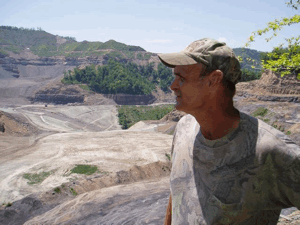
"Like maggots eating our mountainsides." Ed Wiley looks over the mountaintop removal mine just above Marsh Fork Elementary. The ridgeline in the distance will soon be leveled by explosives and the rock and dirt dumped in the valley below. (Photo: Jeff Young)
YOUNG: It’s Living on Earth I’m Jeff Young. Now an update on a story and a little good news for an area that’s had its share of bad—the coal country of southern West Virginia, scene of last month’s mining disaster.
Three years ago we told you about Marsh Fork Elementary, where kids go to school in the shadow of a mountaintop removal coal mine. Dust and fumes from the mine’s coal preparation plant waft over the school. Ed Wiley’s granddaughter, Kayla, was a student there. Wiley told us his granddaughter and other students kept getting mysterious headaches and nausea.
WILEY: And she says, gramps these coalmines are making us kids sick. That hurt. That hurt me. You know, it took her tears to wake me up. And it was like a sledgehammer.
YOUNG: Wiley also discovered that the school is downhill from a massive earthen dam that holds back a lagoon of semi-liquid waste left over from washing coal.
WILEY: And when you've got two point eight billion gallons of toxic sludge sitting over an elementary school, it's not good.

"Like maggots eating our mountainsides." Ed Wiley looks over the mountaintop removal mine just above Marsh Fork Elementary. The ridgeline in the distance will soon be leveled by explosives and the rock and dirt dumped in the valley below. (Photo: Jeff Young)
YOUNG: Wiley was determined to get the kids out of harm’s way. When state and local officials showed little interest in moving the school, Wiley did some moving of his own. He walked all the way to Washington D.C.—a 450-mile, 40-day hike to raise awareness and money to build a new school. It took three years, but his group, Pennies of Promise, recently met its funding goal, making a new Marsh Fork Elementary possible. Ed Wiley, welcome back to living on Earth.
WILEY: Thank you Jeff, how’re you doin’?
YOUNG: I’m doing very well. Well, how does it feel to finally have the money for a new school?
WILEY: It’s not hitting me yet, believe it or not, it’s had a few tears here and there, but I guess the big day is when I come down that road and see the children actually walking in that school. And that’ll be my biggest and greatest reward right there.
YOUNG: Now, this all started with you and your long walk trying to raise money to build a new school. How much did you raise in that first effort there, walking all the way to Washington, D.C.?
WILEY: Well, we first opened up a campaign with different environmental groups a there was a bunch of kids from New York City. Those kids sent 350 dollars. And we had 350 dollars. And we did the walk to draw awareness to reach out to people. We raised 10,400 dollars.

Learning in the shadow of coal. A Massey Energy company coal silo looms over Marsh Fork Elementary. The company wanted to build a second silo even closer to the school. Some parents call the mine a health and safety risk. School principal Louise Maynard says, "we are all going to die of something." (Photo: Jeff Young)
WILEY: Well, when we started out the price tag was a little over five million and you know as time goes by everything goes up—we needed around eight to nine million to do the job.
YOUNG: Now, a million and a half is coming from Massey Energy. This is the company that operated the mine where 29 men died in that disaster. This is the company that operates the mountaintop removal site right next to Marsh Fork Elementary. How do you feel about taking their money for this?
WILEY: Well, you know, everybody’s responsible. Everybody is involved, and you know, they probably should have paid for the whole thing. Why step up to the plate now? They could have built a school long, long time ago. So it’s all political, it’s all everybody’s going to jump on board now and say, well, we helped out this school. And it’s fine; we’ll take their money, anything! Let’s get the kids out of there.
YOUNG: And do you know when the new school might happen?
WILEY: Well, they said they was going to get this moving right away, starting Monday and we found out things are moving. We’re talking 14 months they said, have this new school built—usually takes a little over two years, but they’re going to jump on this right away and get things moving and get this happening and they said about 14 months.

The Massey Energy coal company's slurry impoundment and dam. The small white square in the lower foreground is Marsh Fork Elementary. In 2000, another Massey-owned impoundment failed, releasing tons of liquid waste. "It just does not make sense," mine safety expert Davitt McAteer says, "to put a school and impoundment in close proximity." (Photo: Jeff Young)
YOUNG: Wow. That seems pretty fast.
WILEY: Well, it is, but it’s not fast enough. We need to get them moving a little quicker, I feel we should get some portable classrooms somewhere and go ahead and get the children out of there. It’s still not safe, and just keep working and pray that nothing happens, and the 14 months will come quick.
YOUNG: You and others there have been sounding the alarm for a long time about your concerns about the safety with the slurry impoundment and the blasting and coal preparation plant right near the elementary school there. Do you think the disaster at the Upper Big Branch mine, just up the road there, has changed people’s thinking about this and made them perhaps more receptive to your message that there is potential danger here?
WILEY: Well, of course there’s always been potential danger and yes I hope they would feel that way. You know, we just lost miners probably because of a mine that had a lot of violations, which there’s no probably to it—it did, there were many, many violations there. I been telling people for five and a half years, the dam itself behind Marsh Fork Elementary has violations. Until certain occurrences happen this thing will fail and 977 lives will perish. Just like I say, this is why people die in coal mining accidents because there’s permits that have been filed, but nobody’s enforcing them.
YOUNG: I understand there’s a move afoot to have the new school named Ed Wiley Elementary. What do you think of that?
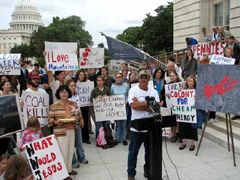
The kids in coal country "deserve a safe, healthy place to go to school," Ed Wiley says on Capitol Hill. He walked all the way from his West Virginia home to raise awareness about Marsh Fork Elementary. (Photo: Vivian Stockman)
WILEY: Well, it would be a great honor, but it does not matter to me. This is for the children and this is for the community, you know, it’s not about me and lets call it the children’s school, whatever, you know? But no, I would be very honored if it would be, but it does not matter at this point. We got the kids in a safe place, now, it does help save the community, but it didn’t stop mountain top removal, and we still have many, many problems here to face and the battle’s not over.
YOUNG: Ed Wiley talking to us about the new home for Marsh Fork Elementary. Thank you very much.
WILEY: Okay, thank you.
YOUNG: I’ll never forget that September day in 2006 when Ed Wiley walked up Capitol Hill in Washington. He’d come a long way to speak his mind, and here’s what he had to say:
WILEY: These kids deserve a chance. Just because they're in the coalfields we'll not be belittled no more. We'll not be beaten down no more. All the children in the Appalachian Mountains need a safe, healthy environment to go to school in.
[CHEERS FROM CROWD]
[MUSIC: Bill Frisell: Creep” from Ghost Town (Nonesuch Records 2000)]
Related links:
- Jeff Young’s 2007 story on the Marsh Fork Elementary School
- Pennies of Promise campaign
From Court House to Home

The Alexander Company specializes in giving new life to old buildings. (Courtesy of the Alexander Company)
YOUNG: Now when it comes to recycling we tend to think of glass and plastic and newspaper. But it can happen on a much larger scale. Entire buildings can be recycled. It’s a process called adaptive re-use, and Joe Alexander, president of the Alexander Company, specializes in partnerships with federal and state agencies to give old buildings new life. He is turning a 1939 courthouse in Kansas City into livable, low-income housing. He says it’s a special—as well as historic—building.
ALEXANDER: The courthouse like so many New Deal projects is a significant, public, government structure. It is a powerful-looking building; it’s a neo-classical design. So when you walk in the front door of the courthouse, you walk into a fantastic public space. The doors are bronze and include emblems that reflect the United States and justice. The court rooms themselves are two story spaces with huge, raised judge’s platforms. And Harry Truman kept his local senate office in this building. This was also the site of an important court decision involving desegregation of a local swimming pool called the Scope Park Swimming Pool decision that was argued in 1952 by Thurgood Marshall, of course he would later go one to represent the nation on the Supreme Court.
YOUNG: So with this reuse, someone’s going to end up in the room where “give ‘em heck” Harry, former president, used to do work? That’s go to be a pretty strong selling point for somebody, huh?
ALEXANDER: It is absolutely. It’s not only a strong selling point to attract people to live downtown, which is part of what makes urban development and adaptive reuse rewarding, but it is genuinely unique. It’s far different, and I think superior product from cookie cutter apartment and mixed-use building that you might find next to a highway or on the periphery.

The salvaged symbols of justice may now become home decorations. (Courtesy of the Alexander Company)
YOUNG: However, old building often have a lot of problems—they might have asbestos, or they’re not terrible efficient. They didn’t used to insulate buildings the way we might like to these days, for example. How do you overcome those kind of obstacles?
ALEXANDER: So dealing with simple things, really, like asbestos and lead paint abatement are things we do all the time. There’s established protocols and beyond that it is a challenge to bring new electrical and heating and cooling systems into a building like this. In the case of the courthouse, we’re lucky that these New Deal era buildings were built like tanks.
YOUNG: So we hear a lot about green building and big push to be greener than the Joneses when you’re building and incorporate what’s called LEED standards—Leadership in Energy and Environmental Design. How does that apply to reuse of old, historic buildings?
ALEXANDER: Well, I think it’s important to start with the background on LEED. It really used to help suburban developers atone for their sins and the sprawl they were creating so they could point to at least an attempt to be environmentally responsible. But the courthouse—if you were say, to tear it down, and in order to build a shiny, new, maybe LEED-certified building you would be demolishing 50 million pounds of existing material. You might be able to recycle a lot of those materials, but that in itself requires processing and time.

The Kansas City courthouse retrofit will save this historic site from becoming 50 million pounds of rubble. (Courtesy of the Alexander Company)
YOUNG: Yeah, I guess it is important to keep in mind that no matter how green we build something that’s new; building anything new has its footprint.
ALEXANDER: Yeah, I absolutely agree. The other really important aspect of a historic building is that they’re important to their community. In the case of the Kansas City courthouse, this building is when it’s completed or refurbished will provide 176 affordable, workforce housing units.
So not only are you attracting new employees downtown to revitalize your urban core, but you’re allowing for diversity both of income and ethnicity. And that is the social justice component of sustainability that’s at least as important as what type of carpet you might use.
YOUNG: Hmm, yeah, so projects like these have an obvious benefit for the city, but to pay for them, how are projects like these going in these strained economic times?
ALEXANDER: Well, there’s not very many of them going. The federal courthouse—the only way that this project was able to go forward like a lot of urban development projects was through a public/private partnership. In this case there was a major focus as part of the stimulus bill on shovel-ready projects. There are few projects that are as shovel-ready as the reuse of an existing building.
YOUNG: So, clearly a lot of advantages to reusing these historic buildings. However, I can think of one possible pitfall here, and that’s ghosts. Any complaints along those lines?
ALEXANDER: [Laughs] We just completely the adapted reuse of a former girl’s school that was later an annex to the Walter Reed Army Medical Hospital in Silver Spring, just outside of Washington, D.C., and we actually did receive a complaint from a resident that there may have been a ghost wandering in what was used as a ballroom by recuperating army soldiers after the Vietnam War.

The Alexander Company specializes in giving new life to old buildings. (Courtesy of the Alexander Company)
YOUNG: I guess this is part of the price of living in a historic building—you have to put up with maybe an old resident still sticking around.
ALEXANDER: We’re working on it, we’re learning about how to deal with ghosts all the time. That’s part of the benefit to it—it makes life a little more interesting.
YOUNG: [Laughs] Joe Alexander is president of the Alexander Company telling us about reuse of historic buildings. Thanks very much.
ALEXANDER: Thank you, I enjoyed it.
Related link:
Check out other Historic Adaptive Reuse Projects from the Alexander Company
A Repurposed Life

The Burton theatre inhabits a closed school in Detroit's Chinatown.
YOUNG: Living on Earth has just launched a new online initiative called Planet Harmony, and each week we’re featuring stories from PH. Planet Harmony’s a place for young people who have often been left out of the environmental debate to report on the issues impacting their communities. Today, Planet Harmony’s Cambrey Thomas brings us a story about second chances in Detroit.
THOMAS: I recently saw Examined Life. The movie follows eight modern thinkers as they move through various cities. The thinkers each had ten minutes to give their thoughts and philosophies to the camera. It was showing in a once abandoned school that’s been repurposed as an independent theater in Detroit’s nearly empty Chinatown. During the previews I studied everything around me because, like the theater itself, everything had a previous life.
The bright red velvet seats were salvaged from a nearby remodeled theater. The projector was an old cast off from another movie house. Even the popcorn machine was an obsolete model from a city-based popcorn company. The funny thing about the whole situation was that I once attended the school before it moved away. I also sat in the seats before because I used to go to concerts at the theater they came from. And I’d probably seen movies from the projector too because I used to trek out to the cinema it came from to see midnight showings.
My observations faded as the movie cued up and the house went dark.
[SOUNDS OF MOVIE PROJECTOR ROLLING]
THOMAS: Princeton Professor Cornel West came up first.

The Burton theatre inhabits a closed school in Detroit's Chinatown.
WEST: It takes tremendous discipline; it takes tremendous courage to think for yourself.
THOMAS: He was sitting in a moving New York City taxi
WEST: The unexamined life is not worth living Plato says in the line 38A in the Apology. How do you examine yourself, what happens when you begin to interrogate yourself. What happens when you begin to call into question your tacit assumptions and unarticulated presuppositions? And begin then a different kind of person.
THOMAS: The unexamined life is not worth living. I settled back into my seat with my popcorn and listened to the ideas of a few more philosophers. But my repurposing thoughts returned when Slovenian theorist, Slavoj Zizek, appeared on the screen dressed like a garbage collector.
[SOUNDS OF GARBAGE DUMP]
ZIZEK: Part of our daily perception of reality is that this disappears from our world.
THOMAS: He was wearing a fluorescent orange vest while pushing around garbage in a giant warehouse of refuse. Zizek spoke about the environment and ecology, but what struck me was his saying that trash does not disappear.
ZIZEK: Of course rationally, you know, it’s there in channelization and so on but at a certain level of your most elementary experience it disappears from your world. The problem is that trash doesn’t disappear.
THOMAS: Trash does not disappear. It seems obvious but it rang even truer coming from a philosopher standing next to a mountain of garbage. He ended by pointing to one of the trash heaps.
ZIZEK: We should learn to love all this.
THOMAS: We should learn to love all this.
ZIZEK: True ecologists love all this.
THOMAS: Zizek could have been pointing to the projector, the seats, the popcorn machine or even the school – they would have been just trash if someone had not loved them enough to rescue them. For Living on Earth and Planet Harmony, I’m Cambrey Thomas.
[MUSIC: Timewarp Inc “I Feel Lucky (Mellow Edit)” from Dub My Funky Groove (Timewarp Music 2005)]
YOUNG: Cambrey Thomas reports for our brand new online offering Planet Harmony, which welcomes all, and is designed to have special appeal for young African Americans.
Check it out and join the discussion at My Planet Harmony dot com. That's my planet harmony dot com.
[MUSIC CONTINUES]
Related links:
- Check out Cambrey's blog at
- Learn more about the Burton theatre here
YOUNG: On the next Living on Earth—One of the nation’s most distinguished scientists returns to Alabama.
WILSON: After 59 years at Harvard, all my adult life, I wanted to go home. So along with the novel I've written a history of that part of the south.
YOUNG: E.O. Wilson—and his novel about ants—next time on Living on Earth.
[MUSIC CONTINUES]
YOUNG: Living on Earth is produced by the World Media Foundation. Our crew includes Bobby Bascomb, Eileen Bolinsky, Bruce Gellerman, Ingrid Lobet, Helen Palmer, Jessica Ilyse Smith, Ike Sriskandarajah, and Mitra Taj, with help from Sarah Calkins, Marilyn Govoni and Sammy Sousa. Our interns are Emily Guerin and Bridget Macdonald. Special thanks to Earth Alert for sound of the Santa Barbara spill. It came from their documentary "Sand, Sun, Oil & Gas". We had engineering help this week from Dana Chisholm. Jeff Turton is our technical director. Alison Lirish Dean composed our themes. Our executive producer is Steve Curwood. You can find us anytime at l-o-e dot org. I’m Jeff Young. Thanks for listening.
ANNOUNCER: Funding for Living on Earth comes from the National Science Foundation, supporting coverage of emerging science. And Stonyfield Farm, organic yogurt and smoothies. Stonyfield pays its farmers not to use artificial growth hormones on their cows. Details at Stonyfield dot com. Support also comes from you our listeners, The Ford Foundation, The Town Creek Foundation, The Oak Foundation, supporting coverage of climate change and marine issues. And Pax World Mutual Funds, integrating environmental, social and governance factors into investment analysis and decision making, on the Web at Pax World dot com. Pax World – for tomorrow.
Living on Earth wants to hear from you!
Living on Earth
62 Calef Highway, Suite 212
Lee, NH 03861
Telephone: 617-287-4121
E-mail: comments@loe.org
Newsletter [Click here]
Donate to Living on Earth!
Living on Earth is an independent media program and relies entirely on contributions from listeners and institutions supporting public service. Please donate now to preserve an independent environmental voice.
NewsletterLiving on Earth offers a weekly delivery of the show's rundown to your mailbox. Sign up for our newsletter today!
 Sailors For The Sea: Be the change you want to sea.
Sailors For The Sea: Be the change you want to sea.
 The Grantham Foundation for the Protection of the Environment: Committed to protecting and improving the health of the global environment.
The Grantham Foundation for the Protection of the Environment: Committed to protecting and improving the health of the global environment.
 Contribute to Living on Earth and receive, as our gift to you, an archival print of one of Mark Seth Lender's extraordinary wildlife photographs. Follow the link to see Mark's current collection of photographs.
Contribute to Living on Earth and receive, as our gift to you, an archival print of one of Mark Seth Lender's extraordinary wildlife photographs. Follow the link to see Mark's current collection of photographs.
 Buy a signed copy of Mark Seth Lender's book Smeagull the Seagull & support Living on Earth
Buy a signed copy of Mark Seth Lender's book Smeagull the Seagull & support Living on Earth

